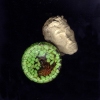우리가 말하고 당신이 들은 이야기
글쓴이
내용
zabel

- 작성시각: 2018.03.02 11:24:19
- 총 작성한 글타래: 195 개
- 총 작성한 댓글수: 14 개
- 가입일: 2013/02/04
- 포인트: 418
- 레벨: 9
- 오프라인 상태입니다
- [email]
글 제목: 작성중 : 뤽 비스컁
(
'.
저잣거리의 드론 사진이 얼마나 함부로 빛을 대하고 있는지를 증빙하는 항공이미지 작업.
.'
+ + +
출처 : 구글이미지 검색
Luc Busquin —Atop The Troposphere
‘The Little Prince’ by Antoine de Saint-Exupéry was one of the first books I read as a child. It is the story of a pilot stranded in the Sahara Desert who meets a young prince fallen to Earth from a tiny planet. The prince famously and absurdly asks the stranded pilot, “Please…Draw me a sheep.”
Inspired by Saint-Exupéry books, I too chose to become an airline pilot. From 1926 until his death in a plane crash in 1943, Saint-Exupéry experienced the world from above, over longer times and distances than others before him. His novels and memoirs are replete with descriptions of mountains, oceans, rivers, and storms. He vividly described the beauty of the world and the formidable challenges facing the pilots of his time. And just as important was his perspective on humanity, and its beauty and challenges. He wrote about the people he met on his adventures, and about the struggles of living in an unforgiving environment.
This series of high altitude aerial photographs from the upper boundary of the troposphere, around thirty-five thousand feet high, offers a perspective of our modern world influenced by Saint-Exupéry. From that ideal height, the beauty of the natural world and the accomplishments of our civilization combine to form mesmerizing scenes. His books left me with the impression that humanity lived concentrated in pockets of civilization separated by almost insurmountable obstacles and vast expanses of wilderness. But clearly visible from high above, more than ninety years after Saint-Exupéry first flew and two hundred years after the industrial revolution, is the enormous impact humanity has had on its environment through large scale alterations of the land. It is not the case any longer that we live on isolated islands of civilization; we live in an interconnected network of infrastructures sprawled across continents. As human population relentlessly grows, only the most arid and rugged regions appear to be awaiting Mankind’s new design.
As Saint-Exupéry explains in ‘The Little Prince’, there were “about two billion grown-ups” in the nineteen-thirties. Today, Earth is home to seven and a half billion of us. The little prince left a planet that was too small to sustain him – an option we don’t have. He cared for his one rose and his three volcanoes as we should for everything that makes Earth our only home.
'.
저잣거리의 드론 사진이 얼마나 함부로 빛을 대하고 있는지를 증빙하는 항공이미지 작업.
.'
+ + +
출처 : 구글이미지 검색
Luc Busquin —Atop The Troposphere
‘The Little Prince’ by Antoine de Saint-Exupéry was one of the first books I read as a child. It is the story of a pilot stranded in the Sahara Desert who meets a young prince fallen to Earth from a tiny planet. The prince famously and absurdly asks the stranded pilot, “Please…Draw me a sheep.”
Inspired by Saint-Exupéry books, I too chose to become an airline pilot. From 1926 until his death in a plane crash in 1943, Saint-Exupéry experienced the world from above, over longer times and distances than others before him. His novels and memoirs are replete with descriptions of mountains, oceans, rivers, and storms. He vividly described the beauty of the world and the formidable challenges facing the pilots of his time. And just as important was his perspective on humanity, and its beauty and challenges. He wrote about the people he met on his adventures, and about the struggles of living in an unforgiving environment.
This series of high altitude aerial photographs from the upper boundary of the troposphere, around thirty-five thousand feet high, offers a perspective of our modern world influenced by Saint-Exupéry. From that ideal height, the beauty of the natural world and the accomplishments of our civilization combine to form mesmerizing scenes. His books left me with the impression that humanity lived concentrated in pockets of civilization separated by almost insurmountable obstacles and vast expanses of wilderness. But clearly visible from high above, more than ninety years after Saint-Exupéry first flew and two hundred years after the industrial revolution, is the enormous impact humanity has had on its environment through large scale alterations of the land. It is not the case any longer that we live on isolated islands of civilization; we live in an interconnected network of infrastructures sprawled across continents. As human population relentlessly grows, only the most arid and rugged regions appear to be awaiting Mankind’s new design.
As Saint-Exupéry explains in ‘The Little Prince’, there were “about two billion grown-ups” in the nineteen-thirties. Today, Earth is home to seven and a half billion of us. The little prince left a planet that was too small to sustain him – an option we don’t have. He cared for his one rose and his three volcanoes as we should for everything that makes Earth our only home.
![]() 없음
없음

Powered by GR Forum




















